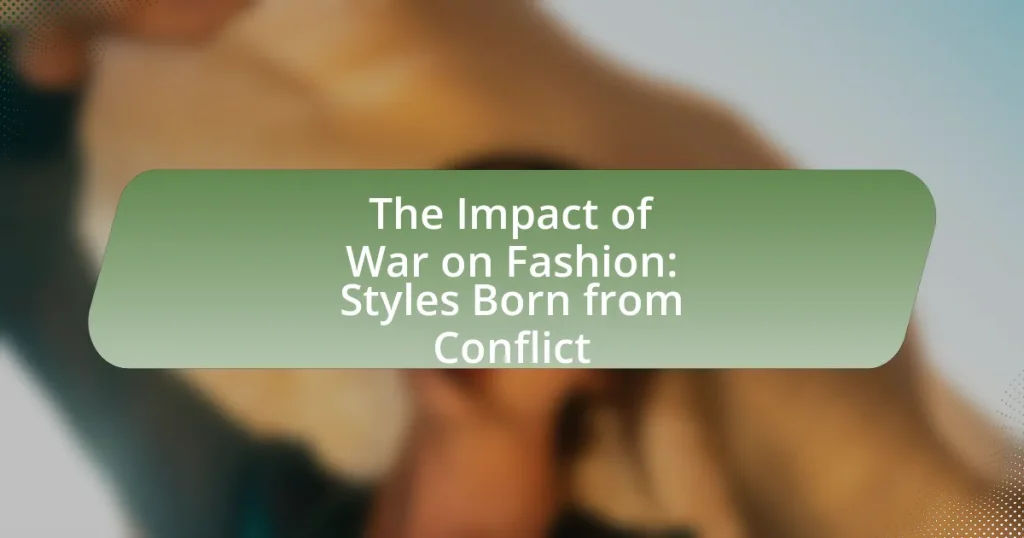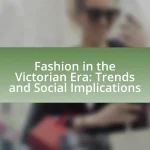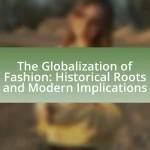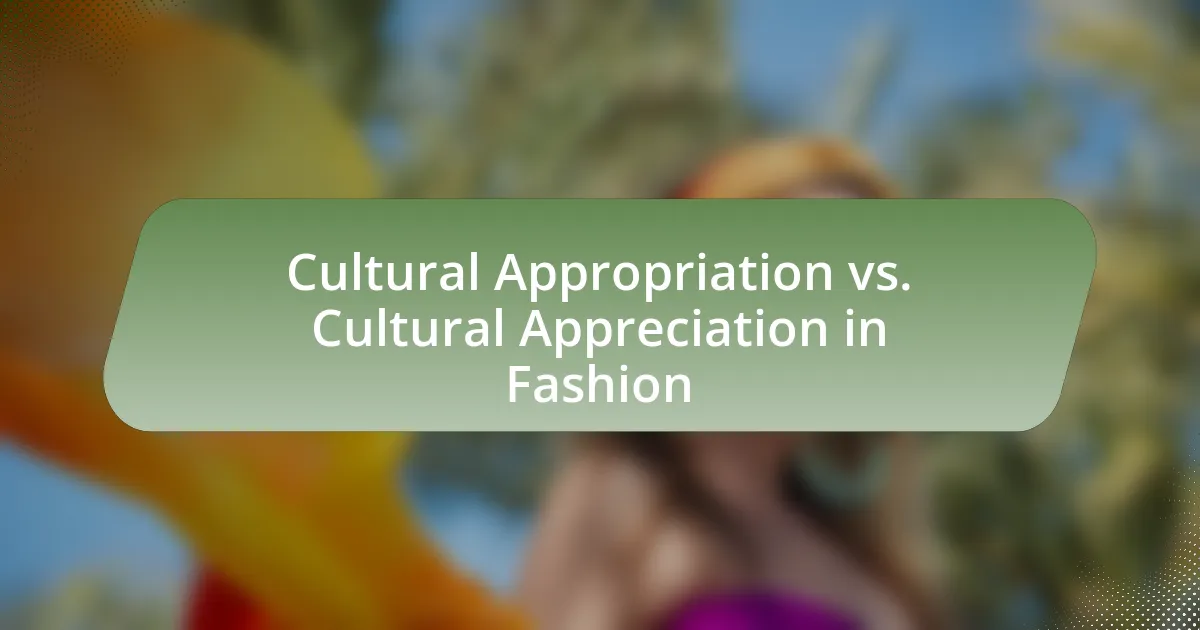The article examines the significant relationship between war and fashion, highlighting how conflicts influence clothing styles, materials, and societal norms. It discusses historical examples, such as the impact of World War I and World War II on women’s fashion and the emergence of utilitarian styles, military-inspired designs, and the “New Look.” The article also explores how wartime needs shape clothing designs, the cultural factors contributing to fashion associations with specific wars, and the role of propaganda and media in promoting wartime fashion. Additionally, it addresses contemporary fashion trends influenced by modern conflicts and offers insights into how consumers can engage with historically significant styles.
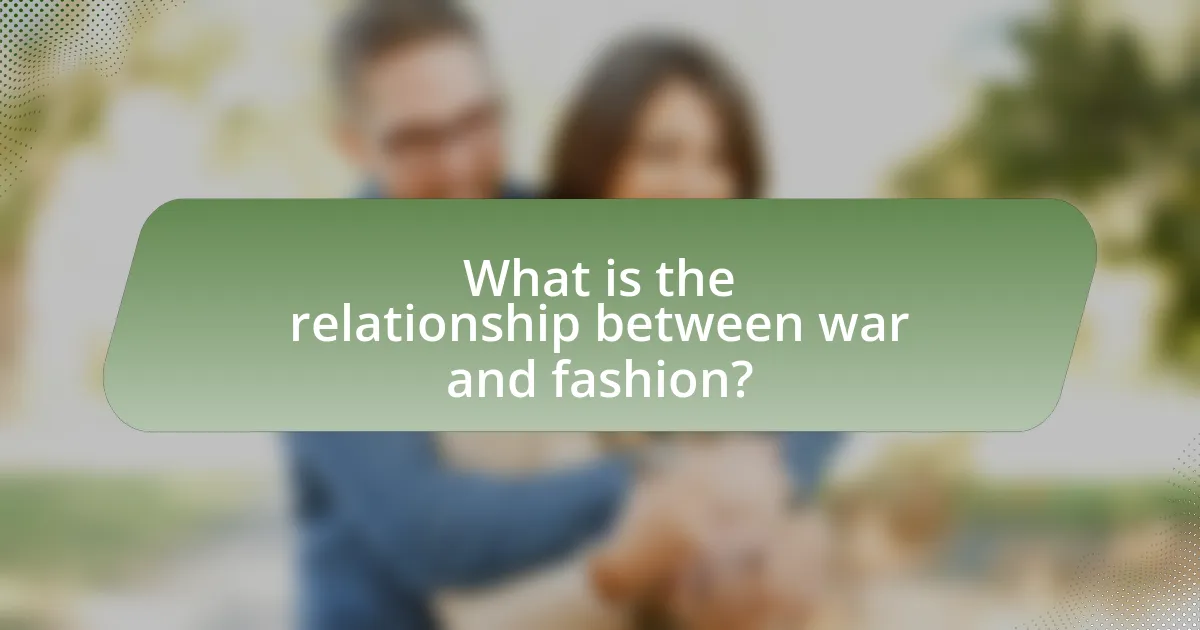
What is the relationship between war and fashion?
The relationship between war and fashion is significant, as conflicts often influence clothing styles, materials, and societal norms. Historical evidence shows that wartime needs lead to practical innovations in fashion, such as the introduction of military-inspired designs and utilitarian garments. For instance, during World War I, women began wearing trousers and more functional clothing as they entered the workforce, reflecting both necessity and changing gender roles. Additionally, the use of surplus military fabrics in civilian clothing after conflicts, like denim from World War II, demonstrates how war can reshape fashion trends. Thus, war acts as a catalyst for both practical adaptations and cultural shifts in fashion.
How has war historically influenced fashion trends?
War has historically influenced fashion trends by driving changes in materials, styles, and societal norms. For instance, during World War I, the need for practicality led to the adoption of more functional clothing, such as shorter skirts and tailored suits, which reflected the changing roles of women in the workforce. Additionally, military uniforms have inspired civilian fashion, with items like trench coats and bomber jackets becoming staples in everyday wear. The post-World War II era saw the rise of the New Look by Christian Dior, which emphasized femininity and luxury as a reaction to wartime austerity. These shifts illustrate how conflict can reshape fashion by altering consumer needs and cultural expressions.
What specific styles emerged during major conflicts?
Military uniforms and utilitarian styles emerged as specific fashion trends during major conflicts. For instance, World War I popularized the trench coat, originally designed for soldiers, which later became a civilian staple. Similarly, World War II saw the rise of bomber jackets and utility clothing, reflecting the need for practicality and durability in wartime. The Vietnam War influenced the adoption of casual styles like cargo pants and tie-dye shirts, symbolizing anti-war sentiments and counterculture movements. These styles not only served functional purposes during conflicts but also left lasting impacts on civilian fashion, illustrating how war can shape cultural aesthetics.
How did wartime needs shape clothing designs?
Wartime needs significantly shaped clothing designs by prioritizing functionality, durability, and resource efficiency. During conflicts such as World War I and World War II, fabric shortages and the necessity for practical attire led to the adoption of simpler silhouettes and the use of alternative materials. For instance, the introduction of utility clothing in Britain during World War II mandated the use of less fabric and more utilitarian designs, which resulted in garments that were both economical and suited for labor-intensive roles. Additionally, military uniforms influenced civilian fashion, with elements like epaulets and khaki colors becoming mainstream. This shift towards practicality in clothing design was a direct response to the demands of wartime, reflecting the need for garments that could withstand the rigors of daily life during conflict.
Why do certain fashion styles become associated with specific wars?
Certain fashion styles become associated with specific wars due to the cultural, social, and economic changes that occur during and after conflicts. For instance, World War I introduced practical clothing like trench coats and military-inspired designs, reflecting the need for functionality in wartime. The influence of soldiers returning home with new styles and the subsequent rise of civilian fashion trends further solidified these associations. Additionally, the scarcity of materials during wars often led to innovative designs that repurposed existing garments, creating a lasting impact on fashion. Historical examples include the adoption of utility clothing in Britain during World War II, which emphasized rationing and practicality, shaping post-war fashion trends.
What cultural factors contribute to this association?
Cultural factors that contribute to the association between war and fashion include the influence of military aesthetics, societal shifts during and after conflict, and the emergence of new materials and technologies. Military aesthetics, characterized by uniforms and utilitarian designs, often permeate civilian fashion, as seen in the adoption of camouflage patterns and military-inspired silhouettes in mainstream clothing. Societal shifts, such as changes in gender roles during wartime, lead to the redefinition of fashion norms; for example, women entering the workforce during World War II resulted in the popularity of practical clothing like trousers. Additionally, advancements in materials, such as the introduction of synthetic fibers during wartime, have transformed fashion production and trends, making styles more accessible and varied. These factors collectively illustrate how war shapes cultural expressions in fashion.
How do propaganda and media play a role in fashion during wartime?
Propaganda and media significantly influence fashion during wartime by shaping public perception and promoting specific ideologies. For instance, during World War II, governments utilized propaganda to encourage citizens to adopt practical clothing styles that reflected patriotism and resourcefulness, such as the “Make Do and Mend” campaign in the UK, which aimed to promote thriftiness and self-sufficiency. Media outlets, including films and magazines, showcased these styles, reinforcing the idea that fashion could serve a national purpose while also boosting morale. This strategic use of fashion as a tool for propaganda not only affected consumer behavior but also led to the emergence of utilitarian designs that prioritized functionality over luxury, reflecting the societal shifts necessitated by wartime conditions.
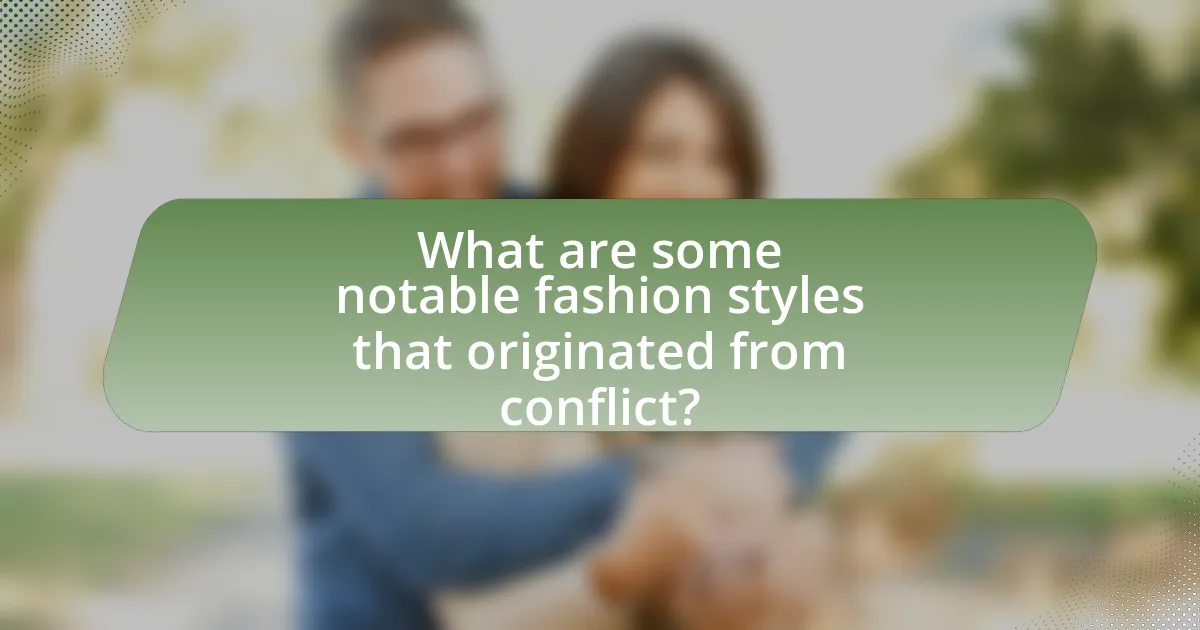
What are some notable fashion styles that originated from conflict?
Notable fashion styles that originated from conflict include military uniforms, punk fashion, and the utility clothing trend. Military uniforms, such as the iconic trench coat and camouflage patterns, were developed for practicality during wartime and have since influenced civilian fashion. Punk fashion emerged in the 1970s as a rebellious response to social and political unrest, characterized by leather jackets, ripped clothing, and DIY aesthetics. The utility clothing trend, which gained popularity during World War II, emphasized functional and durable garments, leading to styles like the bomber jacket and cargo pants. These styles reflect the direct impact of conflict on fashion, showcasing how necessity and rebellion shape clothing trends.
How did World War I impact women’s fashion?
World War I significantly transformed women’s fashion by promoting practicality and comfort over previous styles. The war necessitated women to take on roles traditionally held by men, leading to the adoption of more functional clothing, such as shorter skirts and tailored suits, which allowed for greater mobility. This shift was influenced by the need for women to work in factories and serve in various capacities during the war, resulting in the popularization of garments like the “flapper” dress in the 1920s, which featured a looser fit and dropped waistlines. Additionally, the scarcity of materials during the war led to simpler designs and the use of more affordable fabrics, further altering the fashion landscape.
What changes occurred in women’s clothing during this period?
During this period, women’s clothing underwent significant changes characterized by practicality and functionality due to the demands of wartime. The introduction of more utilitarian designs, such as shorter hemlines and tailored silhouettes, reflected the need for mobility and ease of movement as women increasingly participated in the workforce. Additionally, the use of durable fabrics and simpler styles became prevalent, as resources were limited and the focus shifted towards efficiency. Historical evidence shows that during World War I and World War II, women adopted clothing that allowed them to engage in various roles, from factory work to military service, marking a departure from the restrictive fashions of previous eras.
How did the war influence the adoption of practical styles?
The war significantly influenced the adoption of practical styles by necessitating functional clothing that prioritized utility over aesthetics. During wartime, resources were scarce, leading to the creation of garments that were durable, comfortable, and suitable for various activities, such as work and military service. For instance, the introduction of military uniforms with practical features, like pockets and sturdy fabrics, set a precedent for civilian fashion, promoting similar designs in everyday wear. This shift was evident in the 1940s when women began wearing trousers and utilitarian dresses, reflecting the need for practicality as they entered the workforce in greater numbers due to male enlistment.
What fashion trends emerged from World War II?
Fashion trends that emerged from World War II include utilitarian styles, the popularity of the “New Look,” and the rise of ready-to-wear clothing. Utilitarian styles were characterized by practicality and functionality due to fabric rationing, leading to simpler silhouettes and the use of durable materials. The “New Look,” introduced by Christian Dior in 1947, featured a return to femininity with cinched waists and full skirts, contrasting sharply with wartime austerity. Additionally, the war accelerated the shift towards ready-to-wear clothing, making fashion more accessible to the general public as manufacturers adapted to meet the needs of a changing society. These trends reflect the societal shifts and economic conditions of the time, demonstrating how war influenced fashion significantly.
How did rationing affect clothing production and design?
Rationing significantly impacted clothing production and design by limiting the availability of materials and altering manufacturing processes. During World War II, governments imposed restrictions on fabric usage, leading to the introduction of simpler designs and the use of alternative materials. For instance, the U.S. War Production Board mandated that clothing manufacturers reduce fabric consumption, resulting in shorter hemlines and less intricate styles. This shift not only streamlined production but also encouraged creativity within constraints, as designers adapted to the scarcity by innovating with patterns and cuts. The necessity for practicality over extravagance became a hallmark of wartime fashion, reflecting the broader societal changes driven by the war effort.
What iconic styles were popularized during this era?
The iconic styles popularized during this era include military-inspired fashion, utilitarian clothing, and the emergence of the “New Look” by Christian Dior. Military-inspired fashion became prominent as soldiers returned home, influencing everyday wear with elements like structured silhouettes and functional details. Utilitarian clothing, characterized by practicality and durability, gained popularity due to wartime rationing and the need for versatile garments. The “New Look,” introduced in 1947, revolutionized women’s fashion with its emphasis on femininity, featuring cinched waists and full skirts, marking a significant shift from wartime austerity to post-war opulence. These styles reflect the direct influence of conflict on fashion trends, showcasing how societal changes shape clothing aesthetics.
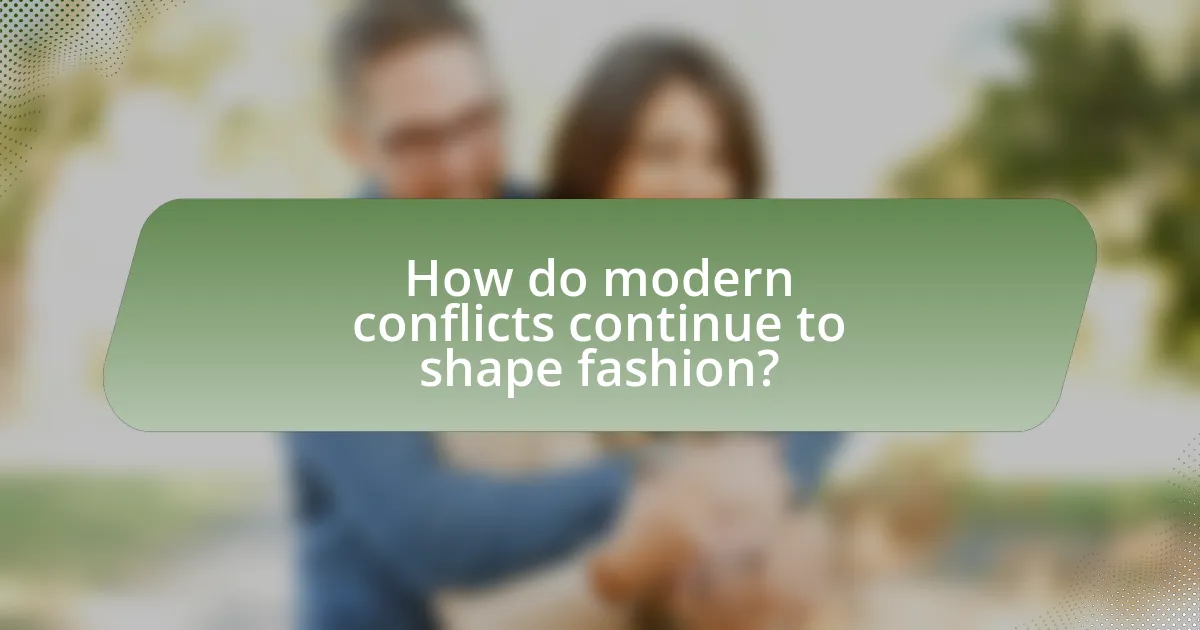
How do modern conflicts continue to shape fashion?
Modern conflicts shape fashion by influencing design, materials, and cultural narratives. For instance, military uniforms have inspired streetwear trends, with items like cargo pants and bomber jackets becoming mainstream fashion staples. Additionally, the rise of sustainable fashion has been driven by the need to address the environmental impact of conflict-related resource extraction, prompting designers to adopt eco-friendly materials. The ongoing refugee crises also lead to the incorporation of diverse cultural elements into fashion, as designers draw inspiration from the traditional garments of displaced populations. These examples illustrate how contemporary conflicts directly affect fashion trends and consumer choices, reflecting broader societal issues.
What contemporary styles can be traced back to recent wars?
Contemporary styles that can be traced back to recent wars include military-inspired fashion, utilitarian aesthetics, and camouflage patterns. Military-inspired fashion emerged prominently after World War II, influencing designers like Yves Saint Laurent, who introduced the “Le Smoking” tuxedo for women, reflecting the gender roles altered by wartime labor. Utilitarian aesthetics gained traction during the Gulf War, with functional clothing emphasizing practicality and durability, seen in brands like A.P.C. and Vetements. Camouflage patterns, initially designed for military use, have been adopted into mainstream fashion, with designers such as Balenciaga and Off-White incorporating them into their collections, showcasing the blending of combat and civilian attire. These styles illustrate how the experiences and necessities of war have shaped contemporary fashion trends.
How do designers draw inspiration from military aesthetics today?
Designers draw inspiration from military aesthetics today by incorporating utilitarian elements, structured silhouettes, and camouflage patterns into contemporary fashion. This trend reflects a blend of functionality and style, as seen in collections from brands like Balmain and Vetements, which often feature military-inspired jackets and cargo pants. The resurgence of these elements can be traced back to the cultural significance of military uniforms, which symbolize strength and resilience, influencing designers to reinterpret these themes in modern contexts. For example, the use of tactical gear in streetwear highlights a growing interest in practicality and durability, aligning with consumer preferences for versatile clothing.
What role does social media play in the dissemination of war-inspired fashion?
Social media plays a crucial role in the dissemination of war-inspired fashion by providing a platform for rapid sharing and visibility of trends influenced by conflict. Through platforms like Instagram, TikTok, and Twitter, designers and brands can showcase collections that draw inspiration from military aesthetics, historical conflicts, or current events, reaching a global audience instantly. For instance, the rise of streetwear brands that incorporate camouflage patterns and military silhouettes can be traced back to viral social media campaigns, which amplify their visibility and desirability. Additionally, user-generated content and influencer endorsements further propagate these styles, creating a feedback loop where war-inspired fashion becomes a part of mainstream culture. This phenomenon is supported by studies indicating that social media significantly influences consumer behavior and fashion trends, highlighting its pivotal role in shaping contemporary fashion narratives.
How can understanding the impact of war on fashion inform current trends?
Understanding the impact of war on fashion can inform current trends by revealing how historical conflicts have shaped styles, materials, and consumer behavior. For instance, World War II led to the introduction of utility clothing, which emphasized functionality and resourcefulness, influencing contemporary minimalist designs that prioritize practicality. Additionally, the post-war era saw the rise of haute couture as a response to wartime austerity, which continues to inspire luxury fashion today. The adaptation of military aesthetics, such as camouflage and utilitarian silhouettes, remains prevalent in modern streetwear, demonstrating how past conflicts continue to resonate in current fashion narratives.
What lessons can designers learn from historical wartime fashion?
Designers can learn the importance of functionality and adaptability from historical wartime fashion. During conflicts, such as World War II, clothing was designed to be practical, durable, and versatile due to resource scarcity and the need for mobility. For instance, the introduction of utility clothing in Britain emphasized efficiency and simplicity, reflecting a shift towards garments that served multiple purposes. This historical context illustrates that fashion can effectively respond to societal needs and constraints, encouraging contemporary designers to prioritize practicality alongside aesthetics in their creations.
How can consumers engage with fashion that has historical significance?
Consumers can engage with fashion that has historical significance by purchasing vintage clothing, supporting brands that honor historical styles, and participating in educational events focused on fashion history. Vintage clothing allows consumers to wear pieces that reflect specific historical periods, such as World War II-era garments, which often feature practical designs influenced by wartime needs. Supporting brands that incorporate historical elements, like military-inspired designs or patterns from past conflicts, connects consumers to the narratives behind those styles. Additionally, attending exhibitions or lectures on fashion history can deepen understanding and appreciation of how war has shaped fashion trends, such as the adoption of utilitarian styles during the 1940s.
What are practical ways to incorporate war-inspired fashion into everyday wear?
Practical ways to incorporate war-inspired fashion into everyday wear include integrating military-style jackets, combat boots, and utilitarian accessories into casual outfits. Military jackets, often characterized by structured silhouettes and functional pockets, can be paired with jeans or dresses for a balanced look. Combat boots, originally designed for soldiers, provide both durability and style, making them suitable for various occasions when matched with casual attire. Additionally, utilitarian accessories such as dog tags or canvas bags can add a subtle nod to military aesthetics without overwhelming the outfit. These elements reflect the influence of wartime fashion on contemporary styles, showcasing how historical designs can be adapted for modern wear.
